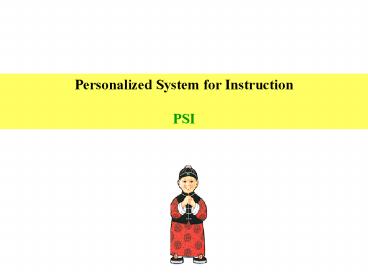Personalized System for Instruction PowerPoint PPT Presentation
1 / 22
Title: Personalized System for Instruction
1
Personalized System for Instruction PSI
2
Reasons Large class Inadequate time
Limited equipment and facilities Wide range of
student ability
Goals Provide more individual instruction
Allow students to progress at their own pace
through a sequence of prescribed learning
tasks Allow students to be independent Allow
teachers to use high rates of interaction with
students
3
Origin Fred Keller (Keller Plan) Early 1960s
Siedentop (1974) introduce PSI to PE Metzler
Sebolt (1994) Personalized Sport Instruction
Series
4
Foundations of PSI for Physical Education Theory
Rationaleapplied behavior analysis Human
learning occurs as a result of interactions
between a person external environment PSI
is based on 4 features 1. The ability to view
creative interesting learning materials
2. Regular, tangible progress toward the course
goals 3. Immediate assessment of learning
4. Individual attention from the instructor
5
Foundations of PSI for Physical
Education Assumptions about teaching and
learning Teaching 1. Task presentation task
structure can be provided by printed,
visual, audio media 2. Teachers primary
function is to interact with students for
learning motivation 3. Student participation
learning is most effective when it is largely
independent of the teacher 4. Planning decisions
are made from data collected on student
learning 5. Not only desirable but possible to
design truly individualized instruction
6
- Foundations of PSI for Physical
Education - Assumptions about teaching and learning
- Learning
- Student learning can occur with little dependent
on the teacher - Students learn content at a different rate
- Students have differing aptitudes for learning
content - If given enough time and/or trials, nearly all
students can - achieve the stated goals of instruction
- Students will be highly motivated responsible
as independent - learners
7
Foundations of PSI for Physical
Education Major theme for PSI students progress
as fast as they can, or as slowly as they need
8
Foundations of PSI for Physical
Education Learning domain priorities
interactions 1st priority Psychomotor
learning Interactions comprehend written
visual media for task
presentation task structure 2nd priority
Cognitive learning Interactions quizzes,
strategy test, rule tests 3rd priority
Affective learning Interactions high level of
independency student self-efficacy
9
Foundations of PSI for Physical
Education Student learning preferences
(Reichmann Grasha, 1974) Avoidant Competitive De
pendent
10
Teaching and Learning
Feature Directness
Direct
Interactive Indirect
Content Selection Management Control
Task Presentation Engagement
Patterns Instructional Interaction
Pacing
Task Progression
11
Teaching and Learning
Feature Predominant engagement
pattern Individual practice engagement (almost
exclusively) Inclusiveness
12
- Teaching and Learning Feature
- Task presentation and task structure
- Task presentation
- Written text
- Photographs
- Illustrations
- Videotapes
- CD ROMs
13
- Teaching and Learning Feature
- Task presentation and task structure
- Task structure should include
- Needed equipment
- Practice space requirement or specific location
- Arranging the learning task
- Perform criteria for accuracy, consistency, time,
etc. - Directions for pursuing the task, including
safety - Procedures for verifying completion of the task
- Six different kinds of tasks (Poole,Sebolt, and
Metzler, 1996) - Readiness drills
- Comprehension tasks
- Criterion tasks
- Challenge tasks
- Quizzes
- Game or match play
14
- Teaching and Learning Feature
- Task presentation and task structure
- Non-mastery attempts
- Verifying proficiency
- PSI course workbook
- Attendance policies
- Class rules disciplinary plan
- Dressing-out policies
- How to get return equipment
- Grading plan applicable policies
- Procedures for starting each class
- Complete content list all PSI learning tasks
with performance criterion - All require reading
- Student progress chart for complete tasks
15
Teacher expertise and contextual
needs Teacher expertise Implementing
developmentally appropriate instruction Learning
objectives Task analysis content
progression Assessment
16
Teacher expertise and contextual
needs Effective teaching skills applied to
PSI Planning managerial plans, content listing,
task analysis, learning activities, task
presentation materials, performance
criteria Time class management workbook
(clear concise) Task presentation
structure Communication writing Instructional
information Review closure (no)
17
Teacher expertise and contextual
needs Student developmental requirements Reading
Technology Personal responsibility Asking for
help
18
Teacher expertise and contextual
needs Contextual needs for
PSI Enough room
Enough equipment
19
Teacher expertise and contextual
needs Teacher and student roles and
responsibilities in PSI Starting
classstudent Bringing equipment to
class---teacher Dispersing returning
equipment---student Roll call---student
teacher Task presentation---student Assessment---s
tudent Monitoring learning progress---student
teacher
20
Teaching learning benchmarks for PSI Teacher
benchmarks Course material---clear? Managerial
time---high/low percentage? Individual
instructional interaction---high rate? Criteria
for tasks are appropriate---yes/no Time for
teacher to witness verify mastery
attempts---too much? Teacher make task
presentation---few/no? Student
benchmarks Understand task presentation---? Stay
on-task---? Set up learning activities from task
structure information---? Inappropriate
progress---? Self-paced progression---? Progressio
n is more or less even---?
21
- Assessing learning in PSI
- For teacher
- Know if task too easy or too difficult
- Calculate the average number of trials students
need - Determine the range of trails to mastery
- Identify students are going too slow need extra
attention - For students
- Get regular knowledge of results tell when they
need extra help from teacher - Project of they are on schedule to complete the
course - Reinforcement for success is frequent
predictable
22
- Selecting modifying PSI for
PE - Types of content for using PSI in PE
- Individual sports
- Team sports
- Recreational activities---bowling, Frisbee
- Dances with prescribed steps---line, square, folk
- Personal fitness concepts
- Personal fitness program
- Grade-level adaptation
- Preschool---no
- Elementary---no
- Middle school/junior high---yes
- High school school---yes
- College/adult---yes

